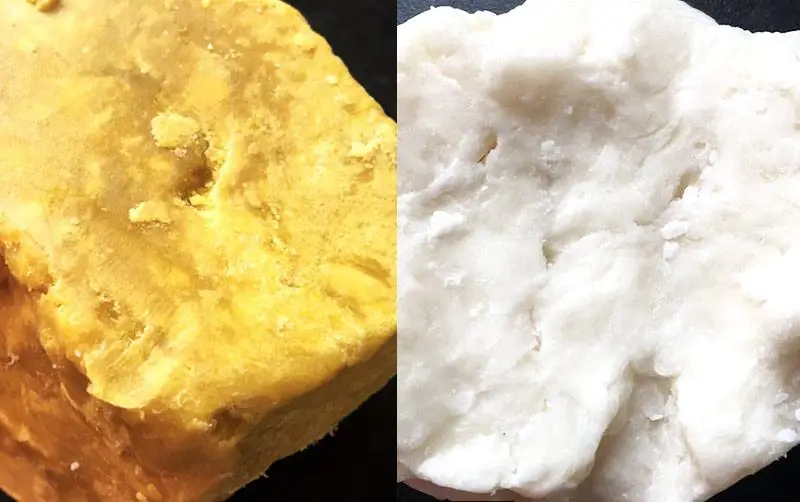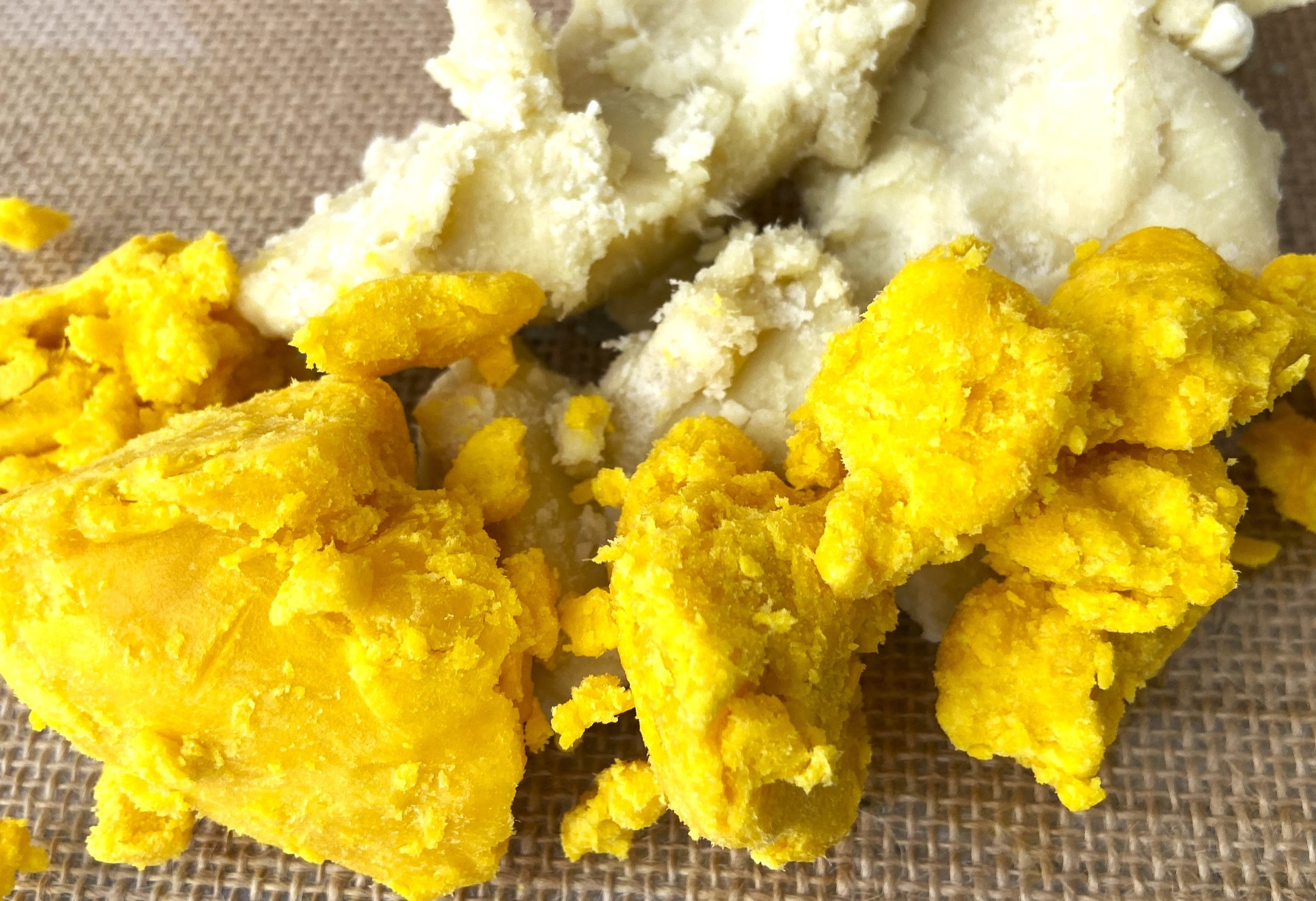Are you looking to switch up your skincare routine with shea butter but feeling confused by the different types available? It can be overwhelming trying to decipher which one is best for your skin. As a self-proclaimed skincare addict, I’ve spent countless hours researching and experimenting with various products, including yellow and white shea butter. And let me tell you, there are some key differences between the two! But don’t worry, I’m here to help you understand them so you can make an informed decision about which type of shea butter is right for your skin.
In this article, we’ll dive into the world of yellow and white shea butter and explore their unique properties, how they’re harvested and produced, as well as their benefits for different skin types. By the end of this read, not only will you have a better understanding of these two popular forms of shea butter but also know which one suits your skin’s needs best. So let’s get started on finding that perfect match for a glowing complexion!
So, yellow vs white shea butter?
The answer to this question ultimately depends on your personal preference and skin type. Yellow shea butter is typically unrefined, meaning it retains its natural color and scent. It also contains more nutrients and antioxidants compared to white shea butter, making it a popular choice for those with dry or sensitive skin.
On the other hand, white shea butter has been refined and bleached to remove its color and scent. This process also removes some of the beneficial properties found in yellow shea butter. However, some people may prefer the neutral smell and smoother texture of white shea butter.
Ultimately, both types can provide moisturizing benefits for the skin. It’s important to choose a high-quality product from a reputable source regardless of which color you prefer.
Understanding the Differences Between Yellow and White Shea Butter
Shea butter is a beloved beauty staple, known for its rich moisture and soothing properties. Among the varieties available, yellow and white shea butter stand out due to their distinct characteristics. Yellow shea butter comes from the nuts of the Vitellaria paradoxa tree and contains higher levels of carotenoids, which give it its vibrant hue. This type offers not only deep hydration but also aids in reducing inflammation, making it ideal for those with dry or sensitive skin. The natural aroma is often more pronounced too, adding a pleasant scent to your skincare routine.
In contrast, white shea butter undergoes a refining process that removes some of these natural pigments and scents. Though still packed with nutrients like vitamins A and E, it has a smoother texture that many find easier to apply without an oily residue. This makes white shea butter particularly suitable for cosmetic formulations where color consistency matters.
Both types can be used effectively across various applications such as lotions, balms, or even hair treatments; choosing between them depends on personal preference regarding texture and fragrance.
Ultimately, whether you reach for yellow or white shea butter may boil down to how you want your skin—or hair—feeling at the end of the day!
Exploring the Harvesting and Production Process of Both Yellow and White Shea Butter
Shea butter, cherished for its nourishing properties, comes from the nuts of the shea tree. The journey begins with traditional harvesting in West African communities, where women often lead the way. They venture into forests to collect ripe fruits, which contain shiny nuts inside. After gathering these treasures, they carefully remove the outer pulp and sun-dry them to enhance flavor and aid in processing. This step is vital as it enhances both yellow and white shea butter’s distinct characteristics. The dried nuts are then cracked open to extract the rich kernels.
Once these kernels are gathered, they undergo a meticulous production process that showcases craftsmanship passed down through generations. For yellow shea butter, artisans roast the kernels before grinding them into a paste; this roasting gives it a beautiful golden hue due to added natural pigments from local plants like safflower or turmeric. In contrast, white shea butter involves no roasting—just grinding raw kernels into a fine consistency before mixing with water and stirring until creamy textures form. Finally, both types are filtered and cooled down for storage. These processes not only yield incredible products but also empower communities by providing jobs and supporting sustainable practices.

Read also: natural moisturizer with spf
Analyzing the Benefits of Yellow and White Shea Butter for Different Skin Types
Shea butter, a luxurious natural product, comes in various forms, with yellow and white being the most popular. Each type has unique properties that cater to different skin needs. Yellow shea butter, derived from the nuts of the African shea tree and often having a rich golden hue, is known for its high content of vitamins A and E. These nutrients work wonders for dry or sensitive skin by providing deep hydration and promoting healing. Its slightly nutty fragrance can also enhance your skincare routine, making it feel like a pampering session every time you apply it.
On the other hand, white shea butter is refined further than its yellow counterpart. This process removes some of its scent but retains an impressive amount of moisture and nourishment for all skin types—especially beneficial for oily or acne-prone complexions due to its non-comedogenic nature. Both types offer remarkable benefits:
- Moisturization: They both deeply hydrate without clogging pores.
- Nourishment: Packed with essential fatty acids and vitamins.
- Soothe Irritation: Ideal for calming inflamed or irritated skin.
Choosing between them depends largely on personal preference and specific skin requirements!
Yellow or White Shea Butter: Making an Informed Decision on Which Type of Shea Butter is Best for Your Skin
When it comes to choosing between yellow and white shea butter, understanding their unique qualities can help make a better choice for your skin. Yellow shea butter, often enriched with natural pigments from the karité tree’s nuts, boasts a vibrant hue that hints at its rich nutrient content. This variety usually has a slightly stronger scent and is packed with antioxidants, making it an excellent option for those looking to nourish dry or aging skin. Its creamy texture melts effortlessly into the skin, providing deep hydration and leaving behind a soft glow.
On the other hand, white shea butter offers a more refined experience. It is typically extracted using traditional methods without any added colorants or strong scents. This makes it ideal for sensitive skin types or anyone who prefers milder products. White shea butter excels in moisturizing while also retaining its beneficial properties like vitamins A and E—great for soothing irritation or redness. When deciding which type suits you best: consider your specific needs!
- If you desire intense hydration: Yellow may be your friend.
- For gentle care on delicate skin: White could shine bright.
